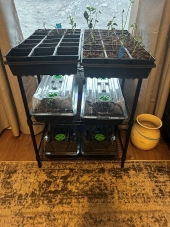Suzette Thib wrote:A challenge I have here is that the local edibles are harder to identify, probably, mostly because they don't come in seed packs (usually) and I find that they occupy more space and time, as well as needing more coddling, before becoming productive. What do yall think? Am I missing a piece in understanding this?
Most urban gardens are not exactly a "natural ecosystem" even if they were before the earth was compacted by big machines, regraded, topsoil removed then maybe replaced, and the typical "heat island" effect of human made ecosystems and change in wind patterns due to buildings, all conspire to quite possibly leave local plants at a disadvantage.
If a person's goal is to produce as many of their own calories as possible on a small piece of land, and think that step one is to improve the soil as many ways as possible. One of those ways is to allow lawn monoculture to gradually turn into a polyculture. Sheep sorrel lives in my lawn in an area, dandelions and their relatives are allowed to grow, but they're imported as are the English daisies. However, both dandelions and English daisies support both native an imported pollinators.
I have a large enough property that I can let native plants move in. One is a native Red Huckleberry. Their berries are far more time-consuming to pick than either my raspberries or the invasive Himalayan Blackberries. I do it because they're awesome in a cake I make, but only if I get the timing right and it's a mast year. I am trying to encourage Salal, which has an easier to pick berry, but mine don't seem to produce berries, unless it's just that the animals get them all first.
However, if you *aren't* planning to get every calorie you can from your land, gradually improving your soil with planting natives in mind will help to support local birds, insects and small animals/reptiles.








